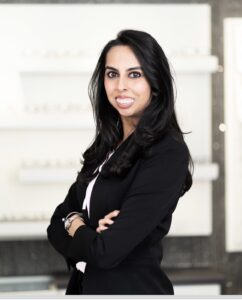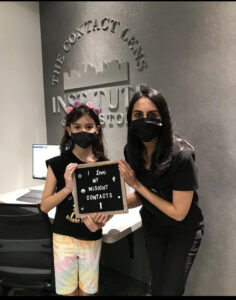May 15, 2023
By Aamena Kazmi, OD, ABO Diplomate
You must start by redefining myopia as a medical diagnosis, describing an elongated eye associated with more serious ocular diseases with higher magnitudes. Once parents hear this, they understand the value in what you are prescribing and are often ready to enroll their child immediately.
Dr. Earl Smith first introduced me to myopia management in a series of lectures outlining his research on the optics of the eye and peripheral defocus during my third year of optometry school. His explanation of how a peripheral myopic defocus could slow myopia progression immediately piqued my interest, as I am a -6.00D myope.
I was intrigued and highly motivated to learn how to implement myopia management in clinical practice to prevent the same fate for my future patients. From here, I prioritized finding a practice with a specialty contact lens and myopia management niche during my externship selection process. Consequently, I spent my summer rotation at Bellaire Family Eye Care, where they were actively prescribing orthokeratology, center-distance soft multifocal contact lenses, hybrid lenses, and pharmaceuticals for myopia management.
Showing Refractive Error Helps Parents Understand Myopia
I was lucky to join a practice that had already embraced myopia management and was engaged in off-label prescribing. When I joined in 2018, I came motivated to grow the existing myopia management niche to greater heights.
We created information packets and referral forms, which we personally delivered to local school nurses and pediatrician offices. Similarly, we designed referral packets that we regularly send to optometry and ophthalmology practices throughout the greater Houston area. These packets include journal review articles, general and lens manufacturer-specific brochures on myopia, management options, and FAQs we compiled throughout the years. Our practice website has a myopia control section that covers much of the same material and allows patients and their parents to review everything we’ve discussed when they’re home.
Parents need to understand the risks of myopia and the importance of myopia control to stimulate their actions. Still, we do not want to leave them with overwhelming anxiety about their child’s ocular and visual health. I begin my discussion by sharing that while their child is nearsighted and that nearsightedness increases in magnitude until the eye matures, there are now treatment programs that can slow the rate of progression, thereby keeping the level of myopia as low as possible and reducing their child’s risk of developing serious, sight-threatening eye diseases later in life. I focus my education on introducing the options of control and what each method will require of them in order to achieve positive results. I devote less time to jargon-heavy explanations of the science behind how each method implements control.
The most powerful thing I do to educate parents about myopia management is also the easiest. I use plus-powered lenses in the exam room to demonstrate their child’s current refractive state and have them compare it to their future refractive error in two to three years if no progression management is initiated. If the child is a -2.00D myope, I have their parents look across the room through a +2.00D lens. Then I either use a myopia calculator (i.e., Brien Holden) or estimate what the child’s refractive error could be in two to three years based on current trends and/or risk factors, and I give the parents a plus-powered lens of equal magnitude to look through to compare. Parents’ jaw-drop reaction (which ALWAYS happens) clearly demonstrates this approach is highly effective. The conversation often shifts from why we should do this to when we can get started.
Sometimes when their child already has a high refractive error, parents will ask why initiating treatment now is essential. The parents will ask, “Why do we need to do this now? Based on this demonstration, our child will already be dependent on glasses or contact lenses for the rest of their life unless they get LASIK.” I immediately use this as an opportunity to begin discussing the increased risk of ocular comorbidities with high myopia that manifest in adulthood. I also share that higher refractive errors threaten LASIK candidacy in the future.
Getting Comfortable Talking About Costs
I think discussing the cost of myopia management treatment is something most optometrists find difficult, and it can be the limiting factor that prevents practices from prescribing. Contact lenses, especially soft multifocal/dual focus lenses, are not difficult to fit/prescribe. The tricky part is having the conversation (which will become more natural and fluid the more you force yourself to have it) and discussing the annual cost, which will recur for several years.
One way around this is having a Care Coordinator who discusses the cost for you after you make clinical recommendations in the exam room (similar to the dental/orthodontist model). However, I have learned over the years that if you simply establish the value of the program you are prescribing, the cost is not intimidating and, instead, is well received. You are no longer just prescribing single vision glasses or contact lenses with the expectation to see the patient in a year for an annual exam.
You must start by redefining myopia as a medical diagnosis, describing an elongated eye associated with more serious ocular diseases with higher magnitudes. It is no longer nearsightedness — a condition with a symptom of nearsightedness/blurry distance vision. Then, you need to describe that your management program will include you monitoring their medical condition (a rapidly elongating eye) with close follow-up (quarterly) and running appropriate testing to manage progression (axial length, refraction, ocular health assessments, contact lens evaluations), as well as an annual supply of lenses. Once parents hear this, they understand the value in what you are prescribing and are often ready to enroll their child immediately.
Many parents ask me why they are just hearing about this. I keep my conversation simple and emphasize this is a new era in optometry, and the standard of care has shifted on account of evidence-based medicine. Medicine is constantly evolving and advancing, and as a result, our clinical practices are shifting. I tell parents that I do not find it surprising that this is the first time they are hearing about myopia management, and that it is my job as their child’s eye care provider to be abreast of the latest research and technology available to make the best recommendations and decisions for them. I also make the conversation relatable. I tell patients and parents about how when I was growing up, I had to turn my older, weaker glasses in for newer, stronger glasses every year without any way to stop the change. Parents often tell me they had a similar experience and are excited to have an opportunity to help their child avoid having the same experience.
Looking Ahead in Myopia Management
The standard of care has truly shifted, and I foresee more and more practitioners embracing myopia management and initiating it in their clinical practice. I also foresee the introduction of more FDA-approved options, leading to a dramatic increase in direct-to-consumer marketing that will make the conversation in the exam room much easier (and even bring in parents who not only already know about the options but are ready to initiate treatment at their first visit). Myopia is an epidemic, and our toolbox to fight the epidemic is going to continue to grow.
 |
Dr. Aamena Kazmi graduated from the University of Houston College of Optometry in 2015, and she is currently an associate at Bellaire Family Eye Care, a private practice in the Houston, TX, area. She primarily manages patients in need of dry eye management, specialty contact lenses, and myopia control. In addition, Dr. Kazmi is a consultant for CooperVision.
|














